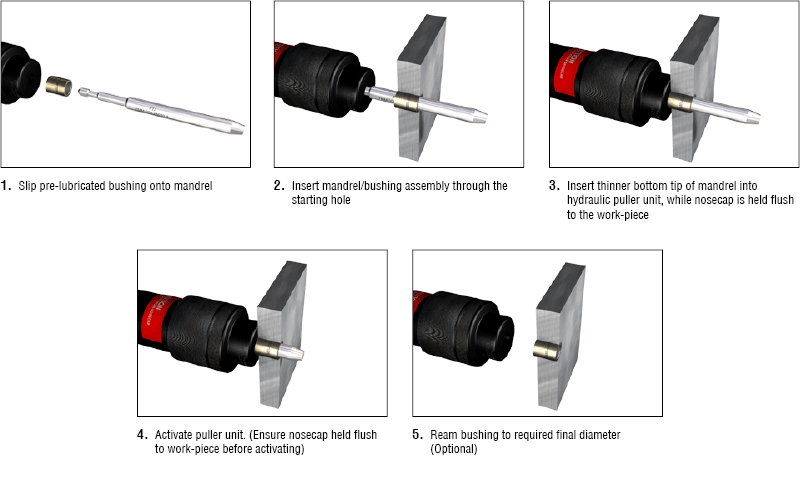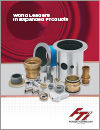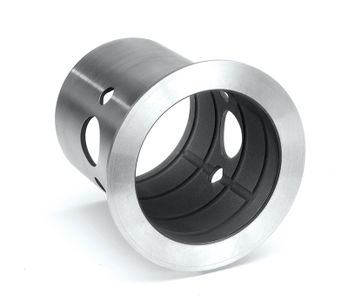High Interference Bushing Installation
One of the most time consuming and complex processes of aircraft manufacturing and repair is bushing installations. Installing a shrink-fit bushing, using dangerous cryogenics, had technicians pounding a frozen bushing into place before it expanded back to its original size.
Not anymore. FTI has taken the proven science of cold expansion to make bushing installations a breeze. Using our technology, aircraft manufacturers and maintenance crews are reducing their bushing installation flow-time and costs while also installing a bushing that is superior in performance than the old shrink-fit or press-fit methods.
The ForceMate System provides an alternative to shrink or press fit bushing installation methods. Use of the system results in consistent high interference bushing installation and enhanced fatigue performance (whether needed or not), at reduced installation cost.
Benefits of ForceMate Bushings
Reduced Installation Cost:
Eliminates the need for cryogenic liquids and significantly reduces installation flow-time while decreasing the safety risk for the technician.
High Resistance to Rotation and Pushout:
The high interference fit provides for greater resistance to rotation or pushout than other bushing installation techniques.
Increased Resistance to Corrosion:
Initial clearance fit insures that corrosion protection coatings (e.g. cadmium plating) remain intact. Since no cryogenic materials are required, the risk of moisture becoming trapped between the bore of the hole and the bushing is eliminated, reducing the risk of corrosion.
Significant Life Improvement:
Beneficial residual compressive stresses are created around the hole and the bushing is installed with a high interference fit. The bushing is initially placed in the hole as clearance fit, and then using an oversized tapered mandrel, the lubricated ForceMate bushing is cold expanded into the hole. The resulting interference fit of the bushing, coupled with simultaneous cold working of the metal surrounding the hole, produces a fatigue life improvement of, typically, 3:1 or better.
The ForceMate Tooling System uses the same Puller Unit and PowerPak as our Split Sleeve Cold Expansion system, however, there are variations in the mandrels, nose caps, and other durable tooling. A complete ForceMate system includes (but is not limited to):
- Cutting Tools
- Mandrel & Nosecap
- Bushings
- Check Gages (combination & mandrel)
- Puller & PowerPak
Installation Procedure
The ForceMate system is comprised of integrated technology and tooling, including ForceMate inserts, mandrels, nosecaps, gages, support assemblies, cutting tools, puller units, special fixtures, and training. Successful implementation and process effectiveness are assured through use of the complete FTI ForceMate system.
BlueCoat™ is an epoxy coating that can be applied on ForceMate bushings to prevent fretting. Used in conjunction with ForceMate, BlueCoat minimizes and prevents fatigue cracking, fretting and corrosion in your bushing installation applications.

Product Brochures
Product Images
Product Specifications
To download
Please contact FTI Sales to obtain the most current ForceMate Specification for your custom application(s).
ForceMate In Composites
FTI’s proven ForceMate bushing installation process works well in composites providing a fast, consistent installation with superior performance to bonded and shrink fit bushings. The process uses a standard FTI puller unit with a different mandrel and nose cap, which are optimized for the unique properties of composite laminates.
The ForceMate bushing installation system facilitates one-up assembly of metal/composite hybrid structures, thereby reducing cycle times and labor costs.
Benefits of ForceMate in Metal-Composite Hybrid Structures
- Installs bushings in the metal and composite at the same time with tailored relative expansion levels.
- Improves the fatigue life of the metal structure.
- Enables structures to be line-reamed without disassembly.
- Eliminates the need to de-burr titanium structure during assembly.
- Provides for simple rework if hole is drilled oversize or off position.
- Supports alignment tolerance.
- Accommodates thermal mis-match of materials.





